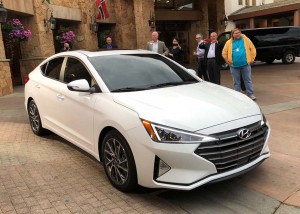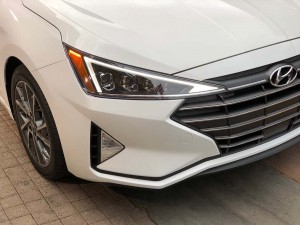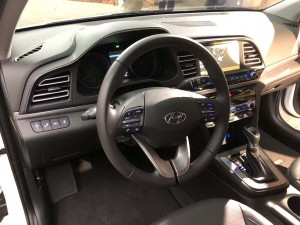Most vehicles undergo modest “mid-cycle” updates three to four years after coming to market, though those usually consist of minor, and often indistinguishable tweaks to soft plastic parts, and the addition of perhaps a few new technology features.
But when the 2019 Hyundai Elantra comes to market this autumn, motorists shouldn’t have any trouble recognizing the changes. The compact sedan unveiled Tuesday evening at an event in Park City, Utah has undergone an unusually extensive makeover for a mid-cycle update, one that includes extensive revisions to the sheet metal up front, as well as the introduction of an eye-catching new feature dubbed a “light guide.” And all but the base version of the 2019 Elantra will now get an extensive array of high-tech safety features.
“The changes we’re making to the Elantra shows our commitment to this segment,” despite the broad market shift from conventional passenger cars to SUVs and other light trucks, said Mike O’Brien, the head of product planning for Hyundai Motor America.
(Exclusive: Hyundai Santa Cruz pickup set to debut in late ’20 or ’21. Click Here for more.)
The typical mid-cycle update is usually limited to the plastic parts of a vehicle’s front fascia. But the 2019 Hyundai Elantra goes several steps beyond that, with new front fenders and a new hood, among other things. In fact, the only sheet metal not changing for the new model-year are the doors, roof and rear quarter-panels.
Visually, one of the most distinctive features being added for 2019 is described as a “light guide.” It’s similar, at first glance, to the LED running lights found on many current vehicles, wrapping around the updated Elantra’s headlights. But when the lights are shut off the accent strip transforms into what appears to be a chrome strip.
Separate daytime running lights, or DRLs, are mounted below the front bumper, framed by the intakes for the new air curtains also being added to the 2019 sedan. The system, routinely used on luxury and high performance vehicles, helps channel air around the front tires to reduce an area of wind turbulence.
Aerodynamics play a major role in the update of the Elantra. The sedan also gets a new underbody pan to further reduce turbulence. Such steps should help improve the new model’s fuel economy, though Hyundai officials said they did not yet have formal EPA mileage ratings to release.
(Hyundai enters the “hot hatch” segment with sporty Veloster N. Click Here to check it out.)
The updates to the Elantra continue inside, with the sedan featuring revisions to its center stack. That includes a new, 8-inch touchscreen display with Apple CarPlay and Android Auto capabilities for top-tier Limited and Sport trim levels. Other versions of the sedan will carry over the 7-inch display in the 2018 Elantra.
Also carried over are the three four-cylinder powertrain options available on the current version of the sedan. That includes:
- A 147-horsepower 2.0-liter inline-4 on Base SE, SEL, Value Edition, and Limited trims. All but the base model get a six-speed manual. The base car features a six-speed manual;
- The Elantra Eco returns gets a 1.4-liter turbo-4 that pumps out 128 hp and is mated to a seven-speed dual clutch automatic;
- Sport versions of the Elantra are powered by a 1.6-liter turbo-4 making 201 hp. Buyers can opt for either a six-speed manual as standard, or seven-speed dual clutch.
Also new for 2019, all but base SE versions of the Hyundai Elantra will be equipped with an extensive array of safety and driver assistance technologies, including: forward-collision warning with automatic emergency braking, blind-spot monitors, lane departure warning with active lane control, a rearview camera and cross-traffic alert. That should cover about 75% of sales in the U.S.
(Funky town meets funky car: First drive in Hyundai Veloster. Click Here for the story.)
Hyundai follows key competitors such as Honda, which is making its similar Honda Sensing system standard across the Civic line-up.
The extent of the mid-cycle makeover for Elantra is unusual but not unique. Toyota made a similarly aggressive move with the last-generation Camry sedan in a bid to fix design problems that had generated poor reviews.
In the increasingly competitive U.S. market, such steps are likely to become more common, especially in the sedan market as manufacturers struggle to retain customers rapidly defecting to SUVs, CUVs and other light trucks.




